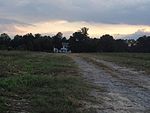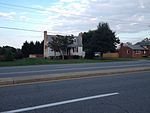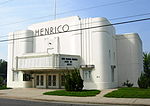Oakley Hill
Central Virginia Registered Historic Place stubsCommons category link is defined as the pagenameGreek Revival houses in VirginiaHouses completed in 1839Houses in Hanover County, Virginia ... and 3 more
Houses on the National Register of Historic Places in VirginiaNational Register of Historic Places in Hanover County, VirginiaPlantation houses in Virginia

Oakley Hill is a historic plantation house located near Mechanicsville, Hanover County, Virginia. It was built about 1839 and expanded in the 1850s. It is a two-story, frame I-house dwelling in the Greek Revival style. On the rear of the house is a 1910 one-story ell. The house sits on a brick foundation, has a standing seam metal low gable roof, and interior end chimneys. The front facade features a one-story front porch with four Tuscan order columns and a Tuscan entablature. Also on the property are a contributing smokehouse and servants' house.It was listed on the National Register of Historic Places in 1995.
Excerpt from the Wikipedia article Oakley Hill (License: CC BY-SA 3.0, Authors, Images).Oakley Hill
Oakley Hill Lane,
Geographical coordinates (GPS) Address Nearby Places Show on map
Geographical coordinates (GPS)
| Latitude | Longitude |
|---|---|
| N 37.595277777778 ° | E -77.34 ° |
Address
Oakley Hill Lane 7127
23111
Virginia, United States
Open on Google Maps







